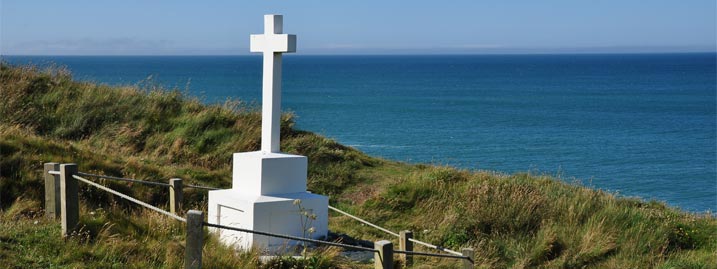
An Unsung Hero
Not all inventors are acclaimed and celebrated for inventions that save lives. Henry Trengrouse was one of these largely unrecognised heroes. Here is his story.
He was born in Helston, Cornwall, UK in 1772. After his education at Helston Grammar School he became a cabinet maker, but an event in December 1807 was to change his life and give him inspiration for a life saving invention.
The HMS Anson, a Royal Navy 44 gun frigate, had left Falmouth and got as far as Ushant, when bad weather forced her to turn back. It seems that the captain mistook the Lizard for Falmouth and the vessel was driven onto a lee shore, the Loe Bar. This great bank of sand separates the estuary of Helston’s River Cober from the sea and the six mile stretch of sea from Rill Head to Porthleven is one of the deadliest of all lee shores. 60 yards from the shore she overturned and although her broken masts formed a rickety bridge to the shore, few of the crew were able to use it.
Henry Trengrouse was one of the hundreds of onlookers who watched helplessly from the beach as 120 men drowned in the boiling surf. No one could throw a line out to the ship against the force of the gale. The tragedy he had witnessed inspired him to devote his life to the mission of the saving lives of sailors wrecked on the bars and rocks of Cornwall’s coast.
At first he attempted to devise a lifeboat, but managed to produce no satisfactory results, so he turned his attention to another method of rescue.
The story goes that it was while watching a firework display on Helston Green, to celebrate George III’s birthday that Helston had the idea that a rocket could be used to power a line from a distressed vessel.
Others had worked on a similar idea. As early as 1791 John Bell had devised an apparatus for throwing a line to vessels from the shore and later Captain George William Manby was perfecting an apparatus very similar to Bell’s. Manby’s invention consisted of a line fastened to a barbed shot, fired from a mortar on the shore. A hawser could then be drawn out from the shore along which a cradle could be run to carry the shipwrecked sailors ashore. Trengrouse’s invention used a rocket, fired by a musket, instead of a mortar and a chair instead of a cradle. This system had several advantages; the rocket was much lighter and more portable than the mortar, the cost was smaller and there was less risk of the line breaking because the speed of the rocket increases gradually, whereas that of a shot is great and sudden. The whole apparatus could be packed into a small chest and carried by vessels of every size.
It was not until 1818, after many journeys to and from London that Trengrouse at last was able to exhibit his apparatus before Admiral Sir Charles Rowley. It was viewed favourably, being recognised as the most perfect way to date of saving lives from shipwrecks. It was suggested that a specimen apparatus should be placed in every dockyard so that naval officers might become familiar with its use and the Elder Brethren of Trinity House recommended that “no vessel should be without it”. Trengrouse named his invention the Bosun’s Chair, but later it became known as the Breeches Buoy. The government ordered twenty sets, but then decided to have them constructed by the ordnance department and paid Trengrouse a mere £50 compensation. In 1821 he was awarded a large silver medal and thirty guineas by the Society of Arts and Alexander I of Russia wrote him an autographed letter and presented him with a diamond ring in recognition of lives saved in the Baltic by his invention. Apart from these Tengrouse earned no monetary reward from his invention even though thousands of lives have been saved because of it.
Another development from the wrecking of the HMS Anson was that it inspired Trengrouse to mount a protest after he saw, with dismay, the victims buried in common graves in unconsecrated ground in the dunes at Loe Bar, near the site of the wreck. He persuaded his local MP, Davies Gilbert, to work for a change in the law. This was successful and from 1808 the practice was abolished.
He also worked on and devised a “self-righting life boat” and a life jacket. The life boat was recognised in Cornwall and Russia, but not by the British Government.
Gradually Trengrouse’s health declined and he died in 1854. He had spent his whole life in Helston and in spite of dedicating a major part of it to saving the lives of sailors, he died penniless. He is buried in the churchyard of St Michael’s Church, Helston and one of the main roads in that town is named after him, Trengrouse Way.

What a tragedy that a man so dedicated and skilled should be virtually unrecognised in his own country. Sailors all over the world owe him a huge debt of gratitude.